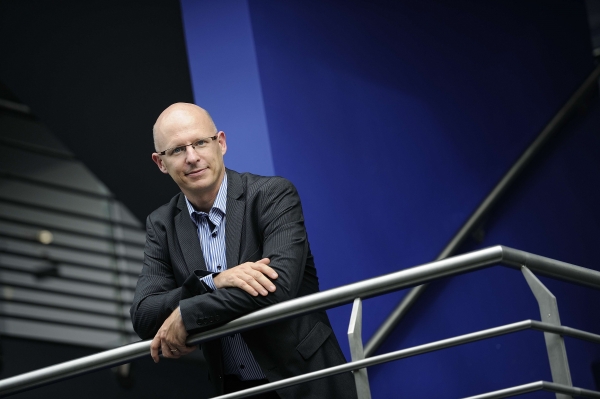The next Nijmegen Lectures will be given by Stanislas Dehaene, Director of the INSERM-CEA Cognitive Neuroimaging Unit near Paris and Professor of Experimental Cognitive Psychology at Collège de France on December 1, 2 and 3, 2021. Please read on for further information on the content of Stanislas Dehaene’s lectures.
Advances in understanding human singularity
What are the origins of the “human singularity”, the rapid emergence, within the primate lineage, of uniquely human abilities such as language, math or music ? My working hypothesis, congruent with prior proposals by Chomsky, Hauser and Fitch, is that the human brain has a special knack for recursive structures, and projects, on the external world, a variety of combinatorial structures to anything that it observes. In various domains and in many if not all brain circuits, brain evolution may have endowed the human brain with a widespread ability to quickly recombine information in the form of nested syntactic structures. In these lectures, I will present new experiment results in three domains: (1) natural and artificial language learning; (2) mathematics; (3) learning to read – all loosely connected by the fact that they involve a capacity to recombine information in novel configurations.
Lecture 1: Natural and artificial languages in humans and monkeys: searching for human singularity
In this first lecture, I will present experiments exploring the representation of natural language in the human brain, and of artificial languages in the human and monkey brains. Using fMRI, MEG and intracranial recordings, we begin to understand how the syntactic structures of language are encoded in the human brain, and can compare them with those of artificial neuronal networks for language processing. Using much simpler sequences, but capitalizing on the ability to record from hundreds of neurons in prefrontal cortex, we begin to analyze how artificial languages are encoded in the monkey brain. I speculate that, in prefrontal cortex, the conscious neural code for sequences is partially but strikingly different in humans and in monkeys.
Discussants
Chris Petkov, Newcastle University, UK
Fenna Poletiek, MPI for Psycholinguistics & Leiden University
References:
Stanislas Dehaene, Florent Meyniel, Catherine Wacongne, Liping Wang, and Christophe Pallier (2015). The Neural Representation of Sequences: From Transition Probabilities to Algebraic Patterns and Linguistic Trees. Neuron, 88(1):2–19. [PDF]
Xinjian Jiang, Tenghai Long, Weicong Cao, Junru Li, Stanislas Dehaene, and Liping Wang (2018). Production of supra-regular spatial sequences by macaque monkeys. Current Biology, 28, 1–9. [PDF]
Lecture 2: The language of geometry
Mathematics is the queen of sciences, perhaps the crowning jewel of human achievements. I will present experiments investigating how mathematical knowledge is represented in the human brain. We have designed extremely simple tests of basic mathematical concepts, particularly those of geometry. Our experiments show that a “language of geometry” is available to all humans, regardless of age and education, but that non-human primates fail to grasp even the most basic of geometrical structures.
Discussants
Andreas Nieder, University of Tübingen, Germany
Evelyn Kroesbergen, Radboud University
References:
Liping Wang, Marie Amalric, Wen Fang, Xinjian Jiang, Christophe Pallier, Santiago Figueira, Mariano Sigman, and Stanislas Dehaene (2019). Representation of spatial sequences using nested rules in human prefrontal cortex. NeuroImage, 186:245—255. [PDF]
Marie Amalric and Stanislas Dehaene (2018). Cortical circuits for mathematical knowledge: evidence for a major subdivision within the brain’s semantic networks. Phil. Trans. R. Soc. B, 373(1740):20160515.[PDF]
Lecture 3: How we learn: neuronal recycling and the neural code for written words
Recent discoveries in cognitive psychology and neuroscience are starting to shed light on what is perhaps the most remarkable competence of the human brain: its capacity to change itself through education. In this talk, I will focus on reading acquisition. By scanning children every two months during the first year of school, as they acquire reading, and by comparing the results with those of illiterate adults, we obtained a detailed picture of how ventral visual cortex and language areas are enhanced by reading acquisition. I will also describe intracranial and single-cell recordings that shed growing light on how the ventral visual pathway recycles itself in order to encode letter strings. Our growing understanding of the psychology and neuroscience of literacy has important consequences for how our schools should teach reading.
Discussant
Falk Huettig, MPI for Psycholinguistics
References:
Dehaene, S. (2020). How We Learn : The New Science of Education and the Brain. Penguin Books Ltd.
Gislaine Dehaene-Lambertz, Karla Monzalvo & Stan Dehaene (2018). The emergence of the visual word form : Longitudinal evolution of category-specific ventral visual areas during reading acquisition. PLoS Biology, 16(3), e2004103. https://doi.org/10.1371/journal.pbio.2004103
Rajalingham, R., Kar, K., Sanghavi, S., Dehaene, S., & DiCarlo, J. J. (2019). A potential cortical precursor of visual word form recognition in untrained monkeys. BioRxiv, 739649. https://doi.org/10.1101/739649
Check here for more information on Stanislas Dehaene.
Organizers:
Simon Fisher, Peter Hagoort, Floris de Lange (DI), Paula Fikkert (CLS),
Ilse van den Dobbelsteen, Martina Bernhard
Location: Aula RU & MPI for Psycholinguistics

Laat een reactie achter